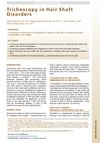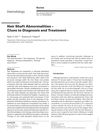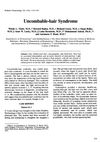Lanceolate Hair-J (LahJ): A Mouse Model for Human Hair Disorders
June 2000
in “
Experimental dermatology
”
TLDR The Lanceolate hair-J mutation in mice mimics human hair disorders like Netherton's syndrome.
The study described the lanceolate hair-J (lahJ) mutation in mice, which arose spontaneously in 1994. These mutant mice exhibited alopecia, lacked vibrissae, and developed wrinkled skin with age. They suffered from a noninflammatory, proliferative skin disease with follicular dystrophy, and their hair fibers showed various abnormalities such as trichorrhexis nodosa, trichorrhexis invaginata, spiral fractures, broken tips, and lance-shaped tips. The mutation shared characteristics with human autosomal recessive ichthyosiform diseases, particularly Netherton's syndrome and monilethrix. The lahJ mutation was located on mouse Chromosome 18 and was associated with elevated serum IgE levels, similar to human Netherton's syndrome.


